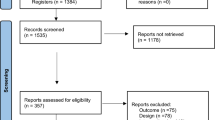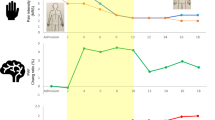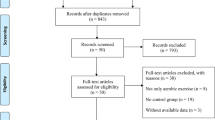Abstract
Study design: Randomized controlled trial of physical exercise and dopaminergic agonist in persons with spinal cord injury and periodic leg movement (PLM).
Objective: The objective of the present study was to compare the effectiveness of physical exercise and of a dopaminergic agonist in reducing the frequency of PLM.
Setting: Centro de Estudos em Psicobiologia e Exercício. Universidade Federal de São Paulo, Brazil.
Methods: A total of 13 volunteers (mean age: 31.6±8.3 years) received L-DOPA (200 mg) and benserazide (50 mg) 1 h before sleeping time for 30 days and were then submitted to a physical exercise program on a manual bicycle ergometer for 45 days (3 times a week).
Results: Both L-DOPA administration (35.11–19.87 PLM/h, P<0.03) and physical exercise (35.11–18.53 PLM/h, P<0.012) significantly reduced PLM; however, no significant difference was observed between the two types of treatment.
Conclusions: The two types of treatment were found to be effective in the reduction of PLM; however, physical exercise is indicated as the first treatment approach, while dopaminergic agonists or other drugs should only be recommended for patients who do not respond to this type of treatment.
Similar content being viewed by others
Introduction
Restless legs syndrome (RLS) and periodic limb movement (PLM) were originally described in 1945 and 1960.1,2 PLM is an asleep phenomenon, characterized by periodic episodes of repetitive and highly stereotyped limb movements. These disturbances may result in decreased sleep efficiency and sleep quality.
A growing number of studies on the treatment of RLS and PLM using increasingly sophisticated methodologies and designs have been published. Clinical features, diagnostic standards, epidemiology, and some aspects of the pathophysiology of RLS and PLM have been studied and further clarified.3,4
Recently, a high incidence of PLM and RLS has been reported in subjects with spinal cord lesions.5,6,7,8 These subjects spontaneously report sleep problems, and even mention the need to be tied to the bed so as to avoid falling on the floor due to the frequency of lower limb movements during sleep.7
Polysomnography, especially all-night studies, supports the diagnosis of RLS by documenting the sleep disturbances and PLM by recording the K-complex. The K-complex is the characteristic wave stage II sleep and occurs with the leg jerk in PLM, roughly assuming the time course of cyclic, alternating patterns.9,10,11 The relationship between RLS and the occurrences of K-complexes and α-activity has been described.12 There is also an important positive correlation between PLM and K-complexes in spinal cord injured and nonparaplegic subjects.8 All-night polysomnographic findings have shown that an increasing sleep latency, an increased number of arousals and decreasing sleep efficiency were all associated with the worsening of symptoms.13,14
The treatment for these disorders can be divided into several categories: (1) primary treatment to reduce subjective symptoms, (2) specific treatment directed at an underlying cause, (3) efficacy and usefulness of secondary treatment, and (4) ancillary treatments of a nonpharmacological nature that may assist therapy.15
Specific treatment includes medication selected from the three primary classes whose effectiveness in RLS/PLM has been well established: dopaminergic agents, opioids, and benzodiazepines. Several studies have reported a favorable treatment outcome of PLM with dopaminergic agonists.16,17 Dopaminergic agents are useful for the treatment of both RLS and PLM, improving all cardinal features of RLS/PLM including subjective discomfort, dyskinesias while awake, and sleep quality. Dopamine precursors were first used and included either regular carbidopa/L-DOPA or sustained–release compounds. Typical doses were 25/100–100/400 (carbidopa/L-DOPA) taken in divided doses before bedtime or before bedtime and during the night.
Reduction of the incidence of PLM and RLS following acute physical activity in these patients may be helpful for the identification of the mechanisms underlying PLM and RLS.7 Thus, it is possible that the reduction of limb movements may stem from endorphin secretion induced by the physical activity,18 since the treatment with opiates often results in a reduction of PLM.19
The objective of the present study was to compare the effects of a dopamine agonist and physical exercise on the treatment of PLM in the spinal cord injury subjects.
Methodology
After all experimental procedures were approved by the Ethics Committee Federal University of São Paulo, 13 male volunteers (mean age: 31.6±8.3 years) were selected following contact through associations for the disabled in the State of São Paulo, Brazil. The selected individuals were clinically stable, with no complications, had a spinal cord injury between T7 and T12 and impairment A=complete (following ASIA scales).20 (Table 1) Total injury to the upper motoneurons as confirmed by radiologic, tomographic, neuroimaging analysis and that they presented index of PLM above 5 PLM/h, diagnosed by means of polysomnography accomplished previously.
A cross-sectional study was conducted in which all volunteers were submitted to the administration of L-DOPA and physical training. L-DOPA (200 mg) in combination with benserazide chloride (50 mg), or placebo was administered for 30 days, 1 h prior to sleeping time. This period of drug administration was followed by a 15-day washout period.
Training was prescribed after all the spinal cord injured individuals underwent a cardiopulmonary exercise test on a computerized metabolic gas exchange system (Vista Turbo Fit, Vacumed, Ventura, CA, USA) using a calibrated electromagnetically braked arm-crank ergometer (CYBEX MET-300, Cybex, USA). The protocol of the maximum effort test consisted of a 2-min warm-up with a load of 25 W in 5-W/min load increments until exhaustion, with 3 min of active recovery at a load of 25 W. Mean rotation speed was 70–80 rpm. The data were calculated automatically using the standard formulae and displayed in a descriptive numerical and graphic form (average of 20 s). The following data were obtained: oxygen uptake (ml/min STPD), carbon dioxide production (VCO2, ml/min STPD), respiratory exchange ratio, minute ventilation (VE, l/min BTPS), respiratory frequency (breaths per min); ventilatory equivalent for O2 and CO2 (VE/VO2 and VE/VCO2); expired fraction of O2 and CO2 (FEO2 and FECO2, mmHg); heart rate (HR, bpm), and oxygen pulse (VO2/HR, ml/bpm). VO2 at the anaerobic threshold (VO2AT) was estimated by the ventilatory method, when VE/VO2 and FEO2 increased while VE/VCO2 and FECO2 remained stable. In the present study, VO2AT was identified in all the patients studied.
The anaerobic ventilatory threshold is a convenient mark used to delimit the upper intensity of aerobic exercise in training programs, corresponding to the work intensity at which the respiratory response to gradual exercise first deviates from linearity - LV1.
The training sessions were held on 45 consecutive days, three times a week, with a mean duration of 30 min, according to the results obtained during the maximum effort test. Total training time depended on the parameters evaluated (heart rate and W). During the sessions, heart rate was monitored and kept at the values established for LV1. Blood pressure measurements were made before and after each training session.
Polysomnography (PSG-Oxford/Medilog eight channels) was performed at the Sleep Institute of the Federal University of São Paulo (UNIFESP/EPM) and the variables observed were three electroencephalogram channels, two electro-oculogram channels, and three electromyogram channels, one of them submandibular and two on the legs (electromyographic recordings of the lower legs were obtained from the tibial muscle and femoris of the thigh). Polysomnographic data were obtained before and after intervention (physical exercise and L-DOPA). Data on leg movements (PLM) were analyzed by the Wilcoxon matched paired test, with the level of significance set at P<0.05.
Results
Physical exercise led to a significant reduction in the frequency of PLM, as seen when comparing basal polysomnographic data with those obtained after 45 days of training (P<0.02). A significant reduction in the frequency of PLM was also observed with the administration of L-DOPA (P<0.03) (Table 2).
Discussion
The two types of treatment were effective in reducing PLM. The reduction of PLM in paraplegic subjects upon physical exercise might be due to the release of β-endorphin and dopamine during exercise. Thus, physical exercise should be prescribed as a treatment approach to PLM and RLS, also in view of its beneficial effects on the quality of life and sleep.21,22,23
The initial hypothesis involving physical exercise is that the reduction of PLM might be influenced by an increase in the release of β-endorphin and dopamine during and after physical exercise, leading to an increase in the activity of the opiate and dopaminergic system,24 thus decreasing PLM scores.
Bulbulian and Darados25 reported an action of ß-endorphins on muscle relaxation in the brain and spinal cord, with correlations between exercise intensity and volume and β-endorphin release/action being demonstrable. Ferreira et al26,27,28 observed pain mediation by opiate receptors at the peripheral level. Since opiate agonists have been shown to be effective in the treatment of PLM, ß-endorphin release during and after physical exercise might have been mediated by opiate receptors at both the central24 and peripheral level26,27,28 in the volunteers studied here.
With respect to dopaminergic agonists, one hypothesis accounting for this imbalance may involve the maintenance of a monosynaptic pathway capable of regulating the transmission of dopaminergic stimuli. Dopamine, by stimulating dopaminergic D2 receptors, might inhibit central cholinergic transmission yielding a neurochemical balance (excitatory/inhibitory), which would prevent the occurrence of such abnormal movements. In our group of paraplegic subjects with complete spinal cord injury, this monosynaptic pathway might have been compromised, leading to the occurrence of such abnormal movements (PLM). Exogenous L-DOPA, seemingly, would reinstate this balance, reducing abnormal movements of the lower limbs.29
The results demonstrate that the two types of intervention were efficient in reducing PLM in paraplegic individuals. A significant reduction in the frequency of PLM was observed for the two treatments when compared to basal levels, but there was no significant difference between treatments. Dopaminergic agonists are only recommended for patients who do not respond to physical exercise.
References
Ekbom KA . Restless legs syndrome. Neurologym 1960; 10: 868–873.
Ekbom KA . Restless legs. Acta Med Scand 1945; 158(Suppl): 123 (abstract).
Hening WA, Walters A, Kavey N, Gidro-Frank S, Côte L, Fahn S . Dyskinesias while awake and periodic movements in sleep in restless legs syndrome: treatment with opioids. Neurology 1986; 36: 1363–1366.
Montplaisir J, Lorrain D, Godbout R . Restless legs syndrome and periodic leg movements in sleep: the primary role of dopaminergic mechanism. Eur Neurol 1991; 31: 41–43.
Yokota T, Hirose K, Tanabe H, Tsukagoshi H . Sleep-related periodic leg movements (nocturnal myoclonus) due to spinal cord lesion. J Neurol Sci 1991; 104: 13–18.
Lee MS, Choi YC, Lee SH, Lee SB . Sleep-related periodic leg movement associated with spinal cord lesions. Mov Disord 1996; 11: 719–722.
De Mello MT, Lauro FA, Silva AC, Tufik S . Incidence of periodic leg movements and of the restless legs syndrome during sleep following acute physical activity in spinal cord injury subjects. Spinal Cord 1996; 34: 294–296.
De Mello MT, Silva AC, Rueda AD, Poyares D, Tufik S . Correlation between K complex, periodic leg movements (PLM), and myoclonus during sleep in paraplegic adults before and after an acute physical activity. Spinal Cord 1997; 35: 248–252.
O'Keeffe ST . Restless legs syndrome. A review. Arch Intern Med 1996; 156: 243–248.
Williams DC . Periodic limb movements of sleep and the restless legs syndrome. VA Med Q 1996; 123: 260–265.
Inami Y et al. A polysomnographic study on periodic limb movements in patients with restless legs syndrome and neuroleptic-induced akathisia. Hiroshima J Med Sci 1997; 46: 133–141.
Montplaisir J, Boucher S, Gosselin A, Poirier G, Lavigne G . Persistence of repetitive EEG arousals (K–alpha complexes) in RLS patients treated with L-DOPA. Sleep 1996; 19: 196–199.
Montplaisir J, Boucher S, Poirier G, Lavigne G, Lapierre O, Lesperance P . Clinical, polysomnographic, and genetic characteristics of restless legs syndrome: a study of 133 patients diagnosed with new standard criteria. Mov Disord 1997; 12: 61–65.
Chokroverty S, Jankovic J . Restless legs syndrome: a disease in search of identity. Neurology 1999; 52: 907–910.
Glausauer FE . Restless legs syndrome. Spinal Cord 2001; 39: 125–133.
Staed J et al. Dopamine D2 receptor alteration in patients with periodic movements in sleep (nocturnal myoclonus). J Neural Trans Gen Sect 1993; 93: 71–74.
Montplaisir J, Godbout R, Pellether G, Warnes H . Restless legs syndrome and periodic limb movements during sleep. In: Kryger MH, Rath T, Dement WC (eds). Principles and Practice of Sleep Medicine, 2nd edn WB Saunders Company: Philadelphia, 1994, P. 589.
Schwarz L, Kindermann W . Changes in β-endorphin levels in response to aerobic and anaerobic exercise. Sports Med 1992; 13: 25–36.
Kavey N, Walters AS, Hening W, Gidro-Frank S . Opioid treatment of periodic movements in sleep in patients without restless legs. Neuropeptides 1988; 11: 181–184.
Maynard FM et al. International Standards for Neurological and Functional Classification of Spinal Cord Injury. Spinal Cord 1997; 35: 266–274.
Vuori I, Urponen H, Hasan J, Partinen M . Epidemiology of exercise effects on sleep. Acta Physiol Scand 1988; 574: 3–7.
Driver HS, Meintjes AF, Rogers GG, Shapiro CM . Submaximal exercise effects on sleep patterns in young women before and after an aerobic training programme. Acta Physiol Scand 1988; 574: 8–13.
Trinder J, Montgomery I, Paxton SJ . The effect of exercise on sleep: the negative view. Acta Physiol Scand 1988; 574: 14–20.
Meeusen R, De Meirleir K . Exercise and brain neurotransmission. Sports Med 1995; 20: 160–188.
Bulbulian R, Darabos BL . Motor neuron excitability: the Hoffmann reflex following exercise of low and high intensity. Med Sci Sports Exer 1986; 18: 697–702.
Ferreira SH, Lorenzetti BB, Corrêa FMA . Central and peripheral antialgesic action of aspirin-like drugs. Eur J Pharmacol 1978; 53: 39–48.
Ferreira SH . Prostaglandins, aspirin-like drugs and analgesia. Nature N Biol 1972; 240: 200.
Ferreira SH, Moncada S, Vane JR . Prostaglandins and the mechanism of analgesia produced by aspirin-like drugs. Br J Pharmacol 1973; 49: 86.
De Mello MT, Poyares DL, Tufik S . Treatment of periodic leg movements with a dopaminergic agonist in subjects with total spinal cord lesion. Spinal Cord 1999; 37: 634–637.
Acknowledgements
We thank AFIP, CEPID (FAPESP Proc. no. 98/143033), Federal Government and the Sleep Institute/UNIFESP.
Author information
Authors and Affiliations
Rights and permissions
About this article
Cite this article
de Mello, M., Esteves, A. & Tufik, S. Comparison between dopaminergic agents and physical exercise as treatment for periodic limb movements in patients with spinal cord injury. Spinal Cord 42, 218–221 (2004). https://doi.org/10.1038/sj.sc.3101575
Published:
Issue Date:
DOI: https://doi.org/10.1038/sj.sc.3101575
Keywords
This article is cited by
-
Accelerometer-measured physical activity and its impact on sleep quality in patients suffering from restless legs syndrome
BMC Neurology (2021)
-
Non-pharmacological methods used in coping with restless leg syndrome (RLS): A systematic review
Sleep and Biological Rhythms (2021)
-
Dopaminergic treatment of restless legs syndrome in spinal cord injury patients with neuropathic pain
Spinal Cord Series and Cases (2016)
-
Using REBT in the Treatment of Restless Leg Syndrome: A Case-Study
Journal of Rational-Emotive & Cognitive-Behavior Therapy (2014)
-
Obesity, diabetes and OSAS induce of sleep disorders: Exercise as therapy
Lipids in Health and Disease (2011)



